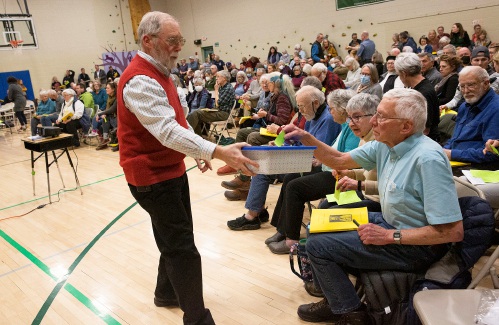
‘Business as an agricultural enterprise’ — Concord Bee Company’s local apiaries flourish
Three years ago, a bear, intelligent in its nefariousness, bypassed an electric fence and broke into one of Jim Watt’s apiaries.

Both remaining Rite Aid stores in Concord slated for closure
The final remaining Rite Aid stores in Concord will shut their doors, with this latest string of closures announced as part of bankruptcy proceedings for the national drugstore chain.
Most Read
 State Supreme Court says towns can keep excess school taxes rather than sharing them with poorer towns
State Supreme Court says towns can keep excess school taxes rather than sharing them with poorer towns
 City prepares to clear, clean longstanding encampments in Healey Park
City prepares to clear, clean longstanding encampments in Healey Park
 Both remaining Rite Aid stores in Concord slated for closure
Both remaining Rite Aid stores in Concord slated for closure
 New fair coming next week to Everett Arena in Concord
New fair coming next week to Everett Arena in Concord
 Universal EFA program sees 500 applications in day one of expansion
Universal EFA program sees 500 applications in day one of expansion
 Big projects, both noticed and ignored, marked Chip Chesley’s long career in Concord
Big projects, both noticed and ignored, marked Chip Chesley’s long career in Concord
Editors Picks
 Missing in Manchester: A timeline of the missing persons investigation for Glenn Chrzan
Missing in Manchester: A timeline of the missing persons investigation for Glenn Chrzan
 Inside EFAs: How school vouchers have fueled a Christian school enrollment boom in New Hampshire
Inside EFAs: How school vouchers have fueled a Christian school enrollment boom in New Hampshire
 New Hampshire filmmakers finish movie in Concord, ten years in the making: ‘Granite Orpheus’
New Hampshire filmmakers finish movie in Concord, ten years in the making: ‘Granite Orpheus’
 Productive or poisonous? Yearslong clubhouse fight ends with council approval
Productive or poisonous? Yearslong clubhouse fight ends with council approval
Sports

Girls’ lacrosse: ‘Who would have thought?’ – Pride team reflects on first state championship appearance in program history
BEDFORD – The Merrimack Valley girls’ lacrosse team’s motto all season was “Who would have thought?” Despite losing in the school’s first-ever girls’ lacrosse state championship, the players stood proudly with their second-place plaque as their fans gave them one last round of applause.
 Softball: Pittsfield loses 1-0 walkoff in D-IV semifinal pitching duel
Softball: Pittsfield loses 1-0 walkoff in D-IV semifinal pitching duel
 Baseball: Concord Christian falls in program’s first semifinal appearance
Baseball: Concord Christian falls in program’s first semifinal appearance
Opinion

Opinion: Friends don’t let friends drive drunk
Benjamin Netanyahu and I agree on virtually nothing. But a statement he made three days after the massacre of 1,200 Israelis by Hamas in October 2023 rings true:
 Opinion: Concord should be run like a household, not a business
Opinion: Concord should be run like a household, not a business
 Opinion: How dark can it get?
Opinion: How dark can it get?
 Opinion: Unfair taxes, unfair schools: The New Hampshire way
Opinion: Unfair taxes, unfair schools: The New Hampshire way

Your Daily Puzzles

An approachable redesign to a classic. Explore our "hints."

A quick daily flip. Finally, someone cracked the code on digital jigsaw puzzles.

Chess but with chaos: Every day is a unique, wacky board.

Word search but as a strategy game. Clearing the board feels really good.

Align the letters in just the right way to spell a word. And then more words.
Politics

New Hampshire school phone ban could be among strictest in the country
When Gov. Kelly Ayotte called on the state legislature to pass a school phone ban in January, the pivotal question wasn’t whether the widely popular policy would pass but how far it would go.
 Sununu decides he won’t run for Senate despite praise from Trump
Sununu decides he won’t run for Senate despite praise from Trump
Arts & Life

Artist spotlight: Jackie Hanson
With creativity abounding in the community around us, The Concord Insider, in collaboration with Concord Arts Market, highlights local artists on a regular basis.
 A sneak peak of summer events in the Concord area
A sneak peak of summer events in the Concord area
 Pierce Manse reopens for the season
Pierce Manse reopens for the season
 Vintage Views: The Liars Club
Vintage Views: The Liars Club
Obituaries
 Donna Lee Rust
Donna Lee Rust
Donna Lee (Raymond) Rust Concord, NH - Donna Lee (Raymond) Rust, 81, passed away on June 5, 2025 at Pioneer Valley Health & Rehabilitation in South Hadley after suffering a recent neck injury, and enduring many years with dementia. Born ... remainder of obit for Donna Lee Rust
 John Pooler Jr.
John Pooler Jr.
John Pooler Jr Daytona , FL - John P. Pooler Jr. passed away January 10, 2025, in Daytona Florida, after a brief illness. John was born in Concord, NH to John Sr. and Nancy (Cournoyer) Pooler on June 30th, 1961. John attended MVHS in Pe... remainder of obit for John Pooler Jr.
 Douglas G. Richards
Douglas G. Richards
Bow, NH - Douglas Gilbert Richards was born in Concord, NH on March 24, 1944. Doug spent the majority of his next 81 years roaming the New England area he so deeply loved. Above all, the central feature of Doug's life was forming and nu... remainder of obit for Douglas G. Richards
 Richard E. Neilson
Richard E. Neilson
Nashua, NH - Richard "Rick" Neilson, 81, passed away on June 9, 2025 after a long illness. Rick was the son of the late Perley Neilson and Bernice (Funk) Procopio and Joseph Procopio. Born and raised in Pittsfield, MA, Rick attended Pit... remainder of obit for Richard E. Neilson


 Where lawmakers disagree: Here are the last few issues still getting hashed out in the State House
Where lawmakers disagree: Here are the last few issues still getting hashed out in the State House
 New hangar for private planes coming to Concord airport
New hangar for private planes coming to Concord airport
 Flights to JFK from Manchester start Friday
Flights to JFK from Manchester start Friday
 Softball: Concord’s underdog run ends in semis to undefeated Lancers, 2-1
Softball: Concord’s underdog run ends in semis to undefeated Lancers, 2-1
 Find a tick on yourself? This NH nonprofit wants to see it.
Find a tick on yourself? This NH nonprofit wants to see it.
 Young Professional of the Month Cady Hickman: Harmonizing Marketing, Marathons and Meaningful Moments
Young Professional of the Month Cady Hickman: Harmonizing Marketing, Marathons and Meaningful Moments
 Baseball: Bishop Brady advances to first final since 1989, Belmont falls in D-III semis
Baseball: Bishop Brady advances to first final since 1989, Belmont falls in D-III semis
 Baseball: John Stark delivers dream scenario in 9-0 semifinal win
Baseball: John Stark delivers dream scenario in 9-0 semifinal win

 Boys’ volleyball: Coe-Brown extends win streak to 18, reaches first championship match in program history
Boys’ volleyball: Coe-Brown extends win streak to 18, reaches first championship match in program history Track & field: John Stark’s Calle sets state record in long jump, Concord’s Saysaw and Goulas have perfect days at MOC
Track & field: John Stark’s Calle sets state record in long jump, Concord’s Saysaw and Goulas have perfect days at MOC Opinion: Our leaders’ puzzling decision to eliminate the State Council on the Arts
Opinion: Our leaders’ puzzling decision to eliminate the State Council on the Arts Concord became a Housing Champion. Now, state lawmakers could eliminate the funding.
Concord became a Housing Champion. Now, state lawmakers could eliminate the funding. ‘A wild accusation’: House votes to nix Child Advocate after Rep. suggests legislative interference
‘A wild accusation’: House votes to nix Child Advocate after Rep. suggests legislative interference  Town elections offer preview of citizenship voting rules being considered nationwide
Town elections offer preview of citizenship voting rules being considered nationwide White Mountain art exhibition makes new home at New Hampshire Historical Society
White Mountain art exhibition makes new home at New Hampshire Historical Society 
